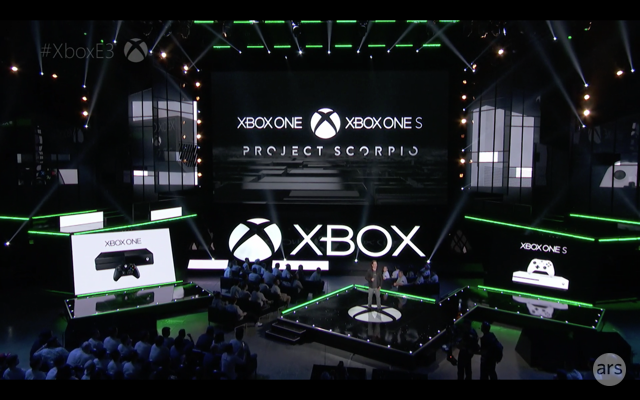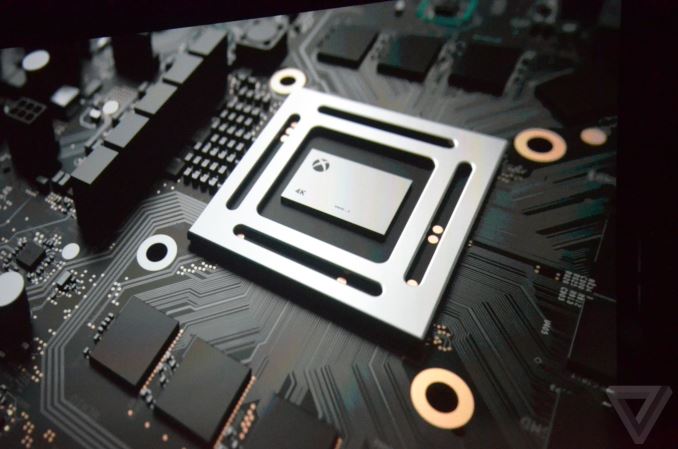Microsoft Teases Project Scorpio for 2017: 8 cores, 6 TeraFLOPs, Backwards Compatible with Xbox. Zen or Jaguar?!
by Ian Cutress on June 13, 2016 2:02 PM EST- Posted in
- Microsoft
- Gaming
- Trade Shows
- Consoles
- E3

This news piece contains speculation, and suggests silicon implementation based on released products and roadmaps.The only elements confirmed for Project Scorpio are the eight cores, >6 TFLOPs, 320 GB/s, it's built by AMD, and it is coming in 2017. If anyone wants to officially correct any speculation, please get in touch.
Here’s an announcement at E3 for you. Microsoft just announced Project Scorpio, an internal project to develop the next generation Xbox set to be released in 2017. Project Scorpio is to be backwards compatible with Xbox One, and seems to be directly in line to compete with whatever Sony are supposedly releasing in the near future. But here’s some specifications for you that has my mind in a twist.
In the presentation, Microsoft states that the Project Scorpio SoC will have eight cores, up to 320 GB/s of memory bandwidth, and over 6 TeraFLOPs of power. To put this into context, this is more processing power than the recently announced AMD RX 480 GPU using a GCN 4 based architecture, set to be launched later this month. Microsoft specifically announced that Project Scorpio is to be launched next year, which puts a few things together worth mentioning.
By this time next year, we expect AMD’s Zen microarchitecture to be in full swing, and AMD has already showcased a silicon sample of an 8-core Zen processor. However, the current Xbox line relies on AMD’s ‘cat’ core architecture, which according to current AMD roadmaps doesn’t seem to feature anywhere for 2017. Without a direct confirmation, it’s hard to tell if Project Scorpio is the same Jaguar cores as the Xbox One, or the newer Zen microarchitecture. I would assume we won’t find out until later next year.
| Microsoft Console Specification Comparison | ||||||||||||||
| Xbox 360 | Xbox One | Project Scorpio | ||||||||||||
| CPU Cores/Threads | 3/6 | 8/8 | 8 / ? | |||||||||||
| CPU Frequency | 3.2GHz | 1.6GHz (est) | ? | |||||||||||
| CPU µArch | IBM PowerPC | AMD Jaguar | ? | |||||||||||
| Shared L2 Cache | 1MB | 2 x 2MB | ? | |||||||||||
| GPU Cores | 768 | ? | ||||||||||||
| Peak Shader Throughput | 0.24 TFLOPS | 1.23 TFLOPS | >6 TFLOPs | |||||||||||
| Embedded Memory | 10MB eDRAM | 32MB eSRAM | ? | |||||||||||
| Embedded Memory Bandwidth | 32GB/s | 102GB/s | ? | |||||||||||
| System Memory | 512MB 1400MHz GDDR3 | 8GB 2133MHz DDR3 | ? | |||||||||||
| System Memory Bus | 128-bits | 256-bits | ? | |||||||||||
| System Memory Bandwidth | 22.4 GB/s | 68.3 GB/s | 320 GB/s | |||||||||||
| Manufacturing Process | 28nm | ? | ||||||||||||
On the GPU side, the current Xbox One uses a 16 CU implementation in the SoC, with two disabled giving 14 CUs. We already know that AMD’s RX 480, running at 5 TFLOPs and built on Global Foundries 14nm FinFET process, runs in at 36 CUs. So Project Scorpio will have easily have more CUs than Xbox One, and judging by the shots in the video, the die size is relatively small. The Xbox One was built on TSMC’s 28nm HP process. At this point it’s still not confirmed if this is an AMD win, however judging by the comments towards backwards compatibility and SoC integration (where CPU and GPU are on the same silicon (or package)), all fingers would point in that direction.
| AMD Radeon GPU Specification Comparison | ||||||
| AMD Radeon RX 480 | AMD Radeon R9 390X | AMD Radeon R9 390 | AMD Radeon R9 380 | |||
| Stream Processors | 2304 (36 CUs) |
2816 (44 CUs) |
2560 (40 CUs) |
1792 (28 CUs) |
||
| Texture Units | (Many) | 176 | 160 | 112 | ||
| ROPs | (A Positive Integer) | 64 | 64 | 32 | ||
| TFLOPs (FMA) | >5 TFLOPs | 5.9 TFLOPs | 5.1 TFLOPs | 3.5 TFLOPs | ||
| Boost Clock | >1.08GHz | 1050MHz | 1000MHz | 970MHz | ||
| Memory Clock | 8Gbps GDDR5 | 5Gbps GDDR5 | 5Gbps GDDR5 | 5.5Gbps GDDR5 | ||
| Memory Bus Width | 256-bit | 512-bit | 512-bit | 256-bit | ||
| VRAM | 4GB/8GB | 8GB | 8GB | 2GB | ||
| Transistor Count | ? | 6.2B | 6.2B | 5.0B | ||
| Typical Board Power | 150W | 275W | 275W | 190W | ||
| Manufacturing Process | GloFo 14nm FinFET | TSMC 28nm | TSMC 28nm | TSMC 28nm | ||
| Architecture | GCN 4 | GCN 1.1 | GCN 1.1 | GCN 1.2 | ||
| GPU | Polaris 10? | Hawaii | Hawaii | Tonga | ||
| Launch Date | 06/29/16 | 06/18/15 | 06/18/15 | 06/18/15 | ||
| Launch Price | $199 | $429 | $329 | $199 | ||
The memory bandwidth of Project Scorpio, 320 GB/s, is also relatively interesting given the current rates of the RX 480 topping out at 256 GB/s. The 320 GB/s number seems round enough to be a GPU only figure, but given previous embedded memory designs is likely to include some form of embedded memory. How much is impossible to say at this point.
AMD has stated that the RX 480 is a VR Gaming capable card, so given what we've said about the Xbox One S tackling VR, it's clear that Project Scorpio is right on the money. AMD's business plan as of late is to expand its custom SoC business, and thus sticking Zen and a GCN 4 based architecture on a combined package or die for Microsoft makes a lot of sense. At the RX 480 announcement, it was stated that AMD wants to power the first 100 million VR users, and this would help towards that goal.
It's worth noting that this news piece contains a decent amount of speculation based on knowledge of the market, and the only elements confirmed for Project Scorpio are the eight cores, >6 TFLOPs, 320 GB/s, and it is coming in 2017. If anyone wants to officially correct any speculation, please get in touch.
Sources: Ars Technica (Carousel Image), Verge Live Blog (Video Screen Capture)
Additional: We can confirm that Scorpio will be an AMD based design, as expected.











101 Comments
View All Comments
Meteor2 - Tuesday, June 14, 2016 - link
Scorpio is 18 months away. It will be Zen.fallaha56 - Tuesday, June 14, 2016 - link
correctT1beriu - Thursday, June 16, 2016 - link
Have you seen the XBOX One S? :)40% smaller + they included the big power brick inside the box. That tells me of big power reduction, thus new SoC on 14nm.
Another hint is the old consoles. Every time a console goes slim is because the SoC manufacturing process goes down. PS3 and XBOX 360 had 3 or 4 process shrinks during their life time. So it's no big deal to put some money on porting Jaguar to 14nm.
RiZad - Thursday, June 16, 2016 - link
Have you ever seen that PS4? "40% smaller + they included the big power brick inside the box. That tells me of big power reduction, thus new SoC on 14nm" That is a horrible assumption considering the PS4 already did those things from launch.fallaha56 - Tuesday, June 14, 2016 - link
think 4 hyperthreaded Zen vs 8not so big...
BehindEnemyLines - Sunday, June 19, 2016 - link
That's considered Quad Core not 8 core CPU like MS mentioned. HT is not a core. It's 4 core 8 threads. You don't advertise a quad-core i7 as eight cores.Krysto - Tuesday, June 14, 2016 - link
Since Zen has multi-threading, it could easily be just a quad-core Zen with 8 threads, so the game engines/developers won't have to change their architectures too much. Even in quad-core form and even with a 1Ghz clock speed, Zen should still be significantly faster than the current Jaguar CPUs.taikamya - Monday, June 13, 2016 - link
I believe this is a great marketing for AMD. Current-gen APU's can't handle 1080p with decent settings. Most APU's can run at 60fps only content displayed in 720p with medium settings. For Microsoft to advertise that in a year and a half, their custom designed SoC will play 4K 60fps, leaves me wondering if the Zen APU (not custom) will deliver at least 1440p @ high settings.It's quite a jump in IGP performance. Definitely worth looking forward to this.
T1beriu - Tuesday, June 14, 2016 - link
A ZEN APU can't deliver 1440p @ high settings because of low memory bandwidth (DDR4). When HBM comes to APUs, then we'll see that kind of performance coming for an APU and that's 2-3 years away.Eden-K121D - Tuesday, June 14, 2016 - link
14nm process needs to be more mature before they could have an APU built on it with HBM 2